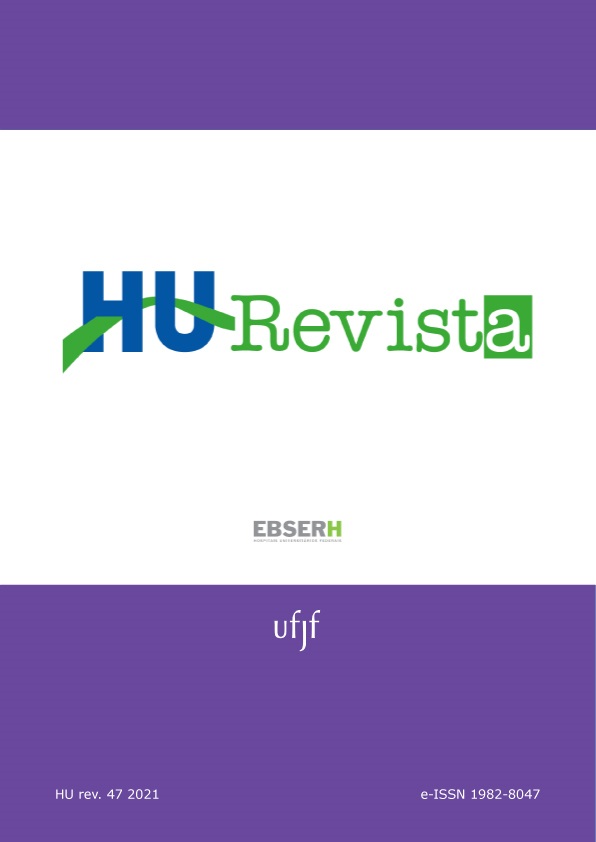People education to prevent HIV/AIDS among adolescents
DOI:
https://doi.org/10.34019/1982-8047.2021.v47.33904Keywords:
Adolescent, Health Education, Health Promotion, HIV, Acquired Immunodeficiency Syndrome, Primary PreventionAbstract
Introduction: The school is considered a favorable scenario for education aimed at preventing HIV and other sexually transmitted infections, as it is an environment where the adolescent spends a large part of their day, it is where the role of knowledge construction can be worked. Objective: To describe the implementation of peer education for the prevention of HIV/AIDS among adolescents in a state school. Methods: This is an action research, where the target audience was 33 adolescents aged 14 to 17 years old, high school students from a state school in the city of Natal/RN. In the first stage, training for information multipliers on HIV/aids prevention among adolescents was initiated, in order to implement the peer education strategy. The second stage was to implement peer education with teenagers, its development was divided into five meetings divided into three phases, with students who participated in the first stage and agreed to continue in the second. Results: In the first phase, the training of information multipliers on HIV prevention among adolescents began. In the second phase, the teaching students chose which methodologies would be used to go over the subjects covered. In the third phase, the educational workshop was implemented with the adolescent teachers and the selected students. Pedagogical proposals based on participatory methodologies were used, with the aim of strengthening knowledge, since such approaches are potentially constructivist and promote greater insertion of the target audience in the teaching-learning process. Conclusions: It was possible to visualize a lack of knowledge on the subjects covered, by showing the vulnerability of the target audience with regard to HIV infection. Encounters with educational approaches involving teenagers at school made these youngsters aware of HIV prevention, making them multipliers.
Downloads
References
Brasil. Ministério da Saúde. Secretaria de Atenção à Saúde. Departamento de Ações Programáticas e Estratégicas. Proteger e cuidar da saúde de adolescentes na atenção básica. Brasília: Ministério da Saúde; 2017 [citado 2018 Nov 16]. Disponível em: http://189.28.128.100/dab/docs/portaldab/publicacoes/saude_adolecentes.pdf
Mesquita JS, Costa MIF, Luna IT, Silva AA, Pinheiro PNC. Fatores de risco e de proteção entre adolescentes em relação às DST/HIV/AIDS. Rev Enferm UFPE On line. 2017; 11(3):1227-33. doi: 10.5205/1981-8963-v11i3a13498p1227-1233-2017
Brasil. Ministério da Saúde. Secretaria de Vigilância em Saúde. Departamento de DST, aids e Hepatites Virais. Boletim Epidemiológico – aids e IST. Brasília: Ministério da Saúde; 2017 [citado 2018 Nov 16]. Disponível em: http://www.aids.gov.br/pt-br/pub/2017/boletim-epidemiologico-hivaids-2017.
Villegas-Castaño A, Tamayo-Acevedo LS. Prevalencia de infecciones de transmisión sexual y factores de riesgo para la salud sexual de adolescentes escolarizados, Medellín, Colombia, 2013. Iatreia. 2016; 29(1):5-17. doi: 10.17533/udea.iatreia.v29n1a11.
Rodrigues JA, Silva LHF, Albuquerque SGE, Nogueira JA, Anjos UU, Nascimento JA. Fatores contribuintes da vulnerabilidade individual dos jovens ao HIV. Rev Bras Ciênc Saúde. 2016; 20(2):141-8. doi: 10.4034/RBCS.2016.20.02.08
Menna T, Ali A, Worku A. Effects of peer education intervention on HIV/AIDS related sexual behaviors of secondary school students in Addis Ababa, Ethiopia: a quasi-experimental study. Reprod Health. 2015; 12(84):1-8. doi: 10.1186/s12978-015-0077-9.
Silva RAR, Nelson ARC, Duarte FHS, Prado NCC, Holanda JRR, Costa DARS. Conhecimento de estudantes adolescentes sobre transmissão, prevenção e comportamentos de risco em relação as DST/HIV/AIDS. J Res Fundam Care Online. 2016;8(4):5054-61. doi: 10.9789/2175-5361.2016.v8i4.5054-5061
Bardin L. Análise de Conteúdo. São Paulo: Edições 70, 2016.
Taquette SR, Rodrigues AO, Bortolotti LR. Infecção pelo HIV em adolescentes do sexo masculino: um estudo qualitativo. Ciênc. saúde coletiva. 2015; 20(7):2193-00. doi: 10.1590/1413-81232015207.18102014.
Silva AT, Jacob MHVM, Hirdes A. Conhecimento de adolescentes do ensino médio sobre DST/aids no sul do Brasil. Aletheia. 2015; (46):34-49.
Silva RAR, Duarte FHS, Nelson ARC, Holanda JRR. A epidemia de aids no Brasil: análise do perfil atual. Rev Enferm UFPE on line. 2013; 1(10):6039-8. doi: 10.5205/reuol.4377-36619-1-ED.0710201327.
Nogueira FJS, Filho CRC, Mesquita CAM, Souza ES, Saraiva AKM. Caracterização dos usuários atendidos em um centro de testagem e aconselhamento em infecções relacionadas ao sexo. Saúde e Pesqui. 2017; 10(2):243-50. doi: 10.17765/2176-9206.2017v10n2p243-250.
Brasil. Ministério da Saúde. Secretaria de Vigilância em Saúde. Departamento de Vigilância, Prevenção e Controle das Infecções Sexualmente Transmissíveis, do HIV/aids e das Hepatites Virais. Prevenção Combinada do HIV/Bases conceituais para profissionais, trabalhadores(as) e gestores(as) de saúde. Brasília: Ministério da Saúde; 2017 [citado 2018 Nov 16]. Disponível em: http://www.aids.gov.br/pt-br/pub/2017/prevencao-combinada-do-hiv-bases-conceituais-para-profissionais-trabalhadoresas-e-gestores.
Oliveira ADS, Nery IS, Gir E, Araújo TME, Júnior FOB. Conhecimentos, atitudes e práticas sobre HIV/aids de mulheres que fazem sexo com mulheres. Rev Enferm UFPE on line. 2017; 11(7):2736-42. doi: 0.5205/reuol.10939-97553-1-RV.1107201712.
Almeida SA, Almeida JN, Trigueiro DRSG, Barrêto AJR, Silva DM, Silva LM. Prevenção do HIV no contexto escolar: o que temos e o que queremos. J Res Fundam Care Online. 2014; 6(supl.):60-70. doi: 10.9789/2175-5361.2014.v6i5.60-70.
UNAIDS/ONUSIDA. Chegando a zero: estratégia do UNAIDS/ONUSIDA 2011-2015. Brasília: UNAIDS/ONUSIDA; 2010 [citado 2018 Nov 16]. Disponível em: http://www.unodc.org/documents/hiv-aids/publications/Other_Publications/O_UNAIDSStrategyGettingToZero_2010_PO.pdf.
Rodrigues CP, Wechsler AM. A sexualidade no ambiente escolar: a visão dos professores de educação infantil. Cad Educ Ensino Soc. 2014; 1(1):89-104.
Santos KB, Murta SG. Influência dos pares e educação por pares na prevenção à violência no namoro. Psicol Cienc Prof. 2016; 36(4):787-800. doi: 10.1590/1982-3703000272014.
Santos, MP, Farre AGMC, Bispo MS, Sousa LB, Marinho DDT. Promoção da saúde sexual e reprodutiva de adolescentes: educação por pares. Rev Baiana Enferm. 2017; 31(3):e21505. doi: 10.18471/rbe.v31i3.21505.
Downloads
Published
How to Cite
Issue
Section
License
Copyright (c) 2021 Fernanda Nahara Carvalho Dossantos, Bárbara Coeli Oliveira da Silva, Vanessa Pinheiro Barreto, Francisco Hudson da Rocha Costa, Eliabe Rodrigues de Medeiros, Alexsandra Rodrigues Feijão

This work is licensed under a Creative Commons Attribution 4.0 International License.
Cessão de Primeira Publicação à HU Revista
Os autores mantém todos os direitos autorais sobre a publicação, sem restrições, e concedem à HU Revista o direito de primeira publicação, com o trabalho licenciado sob a Licença Creative Commons Attribution que permite o compartilhamento irrestrito do trabalho, com reconhecimento da autoria e crédito pela citação de publicação inicial nesta revista, referenciando inclusive seu DOI.









